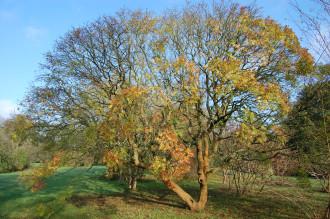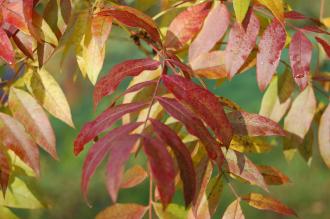
Pistacia chinensis (30/11/2014, Kew Gardens, London)
Position: Full sun
Flowering period: Early spring
Soil: Moist, well drained
Eventual Height: 20m
Eventual Spread: 12m
Hardiness: 7a, 7b, 8a, 8b, 9a, 9b
Family: Anacardiaceae
Pistacia chinensis is a deciduous tree with a rounded habit. Its mid green leaves are pinnate with up to 12 leaflets, up to 25cm long and 15cm broad. Its leaflets are lanceolate to ovate with entire margins, up to 10cm long and 25mm broad. Its leaves turn red/ orange in autumn before they fall in autumn. This tree is dioecious, producing separate male and female plants. Its bark is dark brown. Its yellow/ green flowers appear before its leaves, are produced in panicles. Its male are 7cm long and female are up to 20cm long. Its fruit is a small drupe which is initially red, turning blue when ripe.

Pistacia chinensis Autumn Leaf (30/11/2014, Kew Gardens, London)
Pistacia chinensis, commonly known as Chinese Pistache or Chinese Pitachio, is native to central and western China. In its native habitat it grows in mountain forests on rock soils.
The etymological root of the binomial name Pistacia is from the Greek, a name give to this genus by Nicander in 200BC. Chinensis is derived from the Latin meaning ‘from China’.
The landscape architect may find Pistacia chinensis useful as a small tree with attractive autumn foliage. Once established this tree is drought tolerant.

Pistacia chinensis Bark (30/11/2014, Kew Gardens, London)
Ecologically, Pistacia chinensis fruit are attractive to birds ad some mammals.
Pistacia chinensis prefers moist, fertile, well-drained soils. It tolerates most pH of soil. It will tolerate poor soils.
Pistacia chinensis requires little maintenance.

